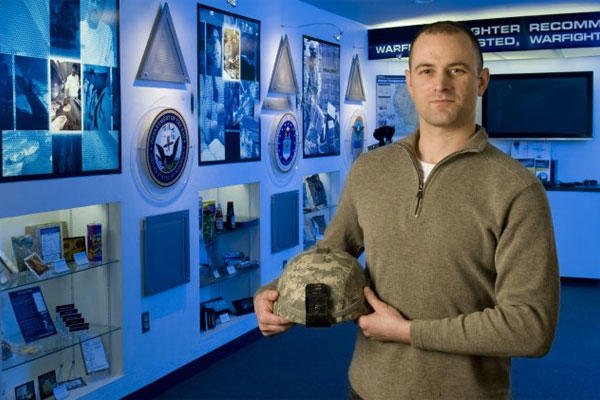NATICK, Mass. -- Staff Sgt. Brian Scott is getting ready to deploy to Afghanistan as a Squad Leader with the 344th Military Police Company, an Army Reserve unit out of Massachusetts, after being wounded in Iraq only five years ago.
On Aug. 28, 2008, Scott's four-vehicle convoy was on a mission to an Iraqi police station. The vehicles were cutting across two main supply routes to get to the station. Scott was in the second vehicle, and a bomb went off between his vehicle and the first vehicle.
"We had to stop and set up security and make calls to (Explosive Ordinance Disposal) and get an outer perimeter security out there," Scott said. Iraqi National Police took care of outer perimeter security, but "they weren't fully doing the job at the time, so I was in charge of interpreters."
Scott had an interpreter in his vehicle who had to be moved to the vehicle behind them to speak to the Iraqi National Police and let them know to start tightening up security on the outside. That's when the unexpected happened.
"As soon as our vehicle backed up, we were hit with another IED," Scott said. "I was cognizant, it knocked me out for a good thirty seconds, but after that I slowly started coming back to reality again, and that's when I realized that I had lost my gunner, that my driver was injured, and my vehicle was disabled."
Scott suffered from a traumatic brain injury; he had shrapnel that was embedded in his left temple that is still there, as well as back injuries.
"The (Advanced Combat Helmet) is something that saved my life," Scott said. "It took most of the shrapnel when we got hit.
"After the blast, they tried to take me out first, but I said, 'No, leave me here take care of my Soldiers first.' So I had them take my driver out, bring him to a vehicle, and then I waited there with my gunner, and then they took me out of the vehicle and brought me to another vehicle."
After the initial shock of the IED blast wore off, Scott was in and out of consciousness. His unit performed a casualty evacuation out of that scene, he went to three different hospitals in Iraq, was medically evacuated from Iraq to Landstuhl, Germany, and then from Germany was medevaced to Walter Reed.
"I actually proposed to my wife, Tanya, at Walter Reed," Scott said. "She was just my girlfriend at the time, and the day I got to Walter Reed she was there, she showed up, and she didn't leave until the day I left. So I figured, 'She's a keeper.'"
While at Walter Reed, Scott went through many physical therapy programs. At first, he couldn't walk very well.
"I was in a wheelchair at first, then a walker, then a cane and then nothing," Scott said.
Scott went through a particularly intensive three-week long physical therapy program while in the Warrior Transition Unit that focused on his back. By the end of that, he was running two miles without problems.
During the year after Scott sustained his injuries, he wasn't sure if he would be medically discharged from the Army.
"There was a point where I thought I was definitely out because they weren't going to let me stay in because of my injuries," Scott said. "But then I started getting better by going through all of the therapies, and it just started to look a little more positive that I was getting back to more normal health. After that, I was more motivated to stay in my full 20 (years)."
Scott was cleared for duty in 2010 and went back to Reserve status. Six months later, he started working as an equipment specialist for the Office of the Director at the Natick Soldier Research, Development and Engineering Center; in addition to procurement of equipment, supplies and rations, he does a lot of outreach and takes part in a lot of events, media visits, VIP ration sampling, and has done several off-sites.
Talking about rations to civilians and veterans alike is rewarding for Scott, as he can discuss seeing the research and development, and also talk about being a customer with the end product and how it is used in the field.
"I think back to when I first came in and how everything for the individual Soldier has progressed since the day I came in the late 90's pre-9/11 with the old (Battle Dress Uniform) and old Kevlar helmets and flak jackets and load-bearing vests with just two straps and a pistol belt to what we have now with the (Improved Outer Tactical Vest) and the ACH."
Although Scott has been busy training for his upcoming mission, a transitional mission training the Afghan National Army and police, he still finds time to support other Wounded Warriors by attending events and talking to other veterans.
The Army is "like a big family" for Scott. "That's the way I look at it," he said. "I've noticed that and I've seen it from the active-duty side, I've seen it from the Reserve side, and now I've seen it from the civilian side. Ever since I was a private in '98, everybody just takes care of each other."
Scott first enlisted in the Army in 1998, spent four years on active duty, and then joined the Army Reserve. He is a lifetime member of the Military Order of the Purple Heart and of the Wounded Warrior Project. Upon his return from duty next year, he will come back to his civilian "family" at NSRDEC.





























